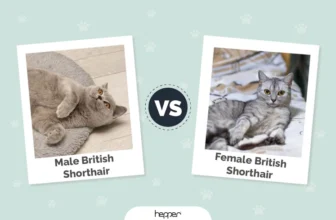Bringing a new cat or dog into an American Shorthair’s territory can be a nerve-racking experience for both pets and owners. It’s crucial to introduce them gradually to prevent aggression and anxiety. However, the process doesn’t have to be a daunting task. With enough patience and the right tools, you can make the integration as smooth and stress-free as possible. In this guide, we will cover everything you need to know to introduce your American Shorthair to a new pet in your household step-by-step. So, let’s get started!
Preparing for the Introduction

Getting ready to introduce your American Shorthair to a new cat or dog in your household may seem daunting, but with the right preparation, the process can be seamless. Before jumping into introductions, it’s important to take several necessary steps to ensure a successful, safe, and stress-free transition. This means scheduling a vet checkup, gathering the proper tools, and creating separate safe spaces for your pets. Proper preparation will make the introduction process smoother and reduce the chance of any aggressive or territorial behavior. For more information on American Shorthair body language and safety tips, check out our article on climbing safety and cat stress management tips.
Schedule a Vet Checkup
As a preliminary step, scheduling a vet checkup is essential before introducing your American Shorthair to a new cat or dog. It’s important to note that many underlying medical conditions can affect how your American Shorthair interacts with other animals. For example, if your cat has any medical issues that cause discomfort or pain, it may react aggressively towards the new pet.
During the checkup, the vet can also ensure that your American Shorthair is up-to-date on all necessary vaccinations and parasite control. This will not only protect your cat but also the new pet from potential diseases.
The vet can provide you with some valuable advice on how to introduce your American Shorthair to another pet successfully. They can also recommend some useful tips to keep your furry companions healthy and happy.
It’s crucial to follow your vet’s advice and recommendations to make sure that your American Shorthair is in the best possible condition before the introduction process.
If you notice any unusual changes in your American Shorthair’s behavior, such as aggression or anxiety, after scheduling veterinary checkups, you should seek professional help immediately. Your vet can help you understand the underlying cause of such behavior and suggest the appropriate way to address the issue.
Scheduling a vet checkup is a vital first step in introducing your American Shorthair to a new pet. It ensures that your furry companion is healthy and ready to interact with other animals. If you want to learn more about possible aggressive or territorial behavior issues your American Shorthair can have, please, follow this link.
Get the Right Tools
To properly introduce your American Shorthair to a new cat or dog, having the right tools is essential. Here are some tools you might consider getting:
- Vet-approved cleaning products: Before introducing new pets, make sure to clean all areas and items they will share, such as litter boxes, food bowls, and toys. Use vet-approved cleaning products to avoid any harm to your pets.
- Gates or barriers: Gates can help keep pets separated while still being able to see and smell each other, which can help with the introduction process.
- Scratching posts: This can provide a safe and appropriate outlet for your cats to scratch and stretch, preventing territorial behavior or aggression.
- Treats and toys: Use treats and toys as positive reinforcement for good behavior during the introduction process.
It’s important to keep in mind that American Shorthairs have unique behaviors and preferences. Familiarizing yourself with their body language and behavioral tendencies can help you to choose the right tools for a successful introduction. For example, American Shorthairs may exhibit territorial behavior or aggressive tendencies towards new pets. To avoid any harm to your pets, make sure to introduce a new pet to your American Shorthair slowly and gradually. If you notice any aggressive behavior, it’s important to address it before it becomes a bigger issue. For more information on managing aggressive behavior in American Shorthairs, visit this link.
Create Separate Safe Spaces
Creating separate safe spaces for your American Shorthair and the new cat/dog is an essential step in preparing for their introduction. This creates a space where each pet can retreat to whenever they feel uncomfortable or overwhelmed. Here are some steps to follow when creating separate safe spaces:
- Choose a separate room for each pet where they can feel secure and relaxed. It should be a quiet area that is away from any high traffic areas and noise. Make sure each room contains all the necessary essentials such as food, water, and litter box.
- Provide comfortable bedding for both pets to snuggle on. This will help them feel comfortable and relaxed in their own space.
- Use pheromone sprays or diffusers to help calm both pets. Pheromones mimic the natural chemicals that cats and dogs produce to calm themselves, making them feel more secure.
- Offer plenty of toys and scratching posts to keep your American Shorthair entertained while they are separated from the new pet. This will help them associate their safe space with positive experiences.
It’s important to remember that while creating separate safe spaces, you should also be mindful of the territorial behavior of American Shorthairs. They can be quite possessive of their space and belongings. Similarly, introducing a new pet can be a stressful experience for your American Shorthair, especially if they’re not used to sharing their space. By creating a separate safe space, you’re giving each pet the opportunity to reduce stress and adjust to their new living arrangements.
Slow and Steady Wins the Race: Introduction Process

The introduction process for introducing your American Shorthair to a new cat or dog must be handled with patience and care to avoid any potential behavioral or stress-related issues. By taking the time to properly introduce your pets, it can help ensure a smoother transition and a lasting harmonious relationship. The process involves several steps, with the goal being for both animals to feel comfortable with each other’s presence. Before starting the slow introduction process, it is important to take a look at the preparation steps to have a successful introduction. Check for any important behavioral cues from your American Shorthair, which can be found in their body language, and take into account the development stage that they are in from their kittenhood before proceeding.
Start with Scent Swapping
Introducing your American Shorthair to a new cat or dog can be stressful for both pets. It is important to take the introduction process slow and follow a step-by-step plan to ensure a successful outcome. One of the first steps in the introduction process is scent swapping.
Scent Swapping
Scent swapping involves allowing your pets to get used to each other’s scent without actually meeting. Here are some steps to follow:
| Step | Action |
|---|---|
| 1 | Take a cloth or towel and rub it gently on one pet. |
| 2 | Take the same cloth and rub it on the other pet. |
| 3 | Place the cloth in the separate safe space of the other pet. |
| 4 | Repeat this process several times a day for several days before moving on to the next step. |
This process helps your pets become familiar with each other’s scent before actually meeting. It is important to keep the separate safe spaces during this time to prevent your pets from becoming stressed or over-stimulated. By gradually introducing their scents, your pets will become more comfortable with each other’s presence.
Next, we will discuss the next step in the introduction process: Starting with brief meetings.
Start with Brief Meetings
Start with Brief Meetings
After exchanging scents and having good reactions from each other, it’s time to move on to in-person introduction, but remember that slow and steady wins the race. The first step is to introduce them at mealtime. Prepare separate bowls for each cat/dog and place them across the room from each other. This brief meeting will ‘prime’ them for more interaction in the future.
If both pets react well during mealtime, the next step is to let them play together. Keep the initial playtime short. About ten minutes should suffice. Plan for at least one play session per day to keep building their relationship. Encourage interactive play with toys they can enjoy together like a feather or laser pointer.
Another option is to put them in the same room for a brief period while supervising their interaction. Use this time to observe their body language, reactions, and energy levels. If they are calm and relaxed, it’s a good sign for their future interactions.
Remember, it’s important never to force the introduction too quickly or aggressively. Every pet is unique and has their way of acclimating. So, be patient, and don’t be afraid to take things slow; it will prevent aggression and anxiety issues.
Additionally, just like humans, cats and dogs can be very particular about sharing. It’s essential to be sensitive to each pet’s preferences and prevent them from fighting over resources like litter boxes and food. You can learn more about your American Shorthair’s litter preferences if you’re unsure and want to make sure you’re providing them with a comfortable and secure environment.
Gradually Increase Time Together
Once your pets have had successful brief meetings, you can start gradually increasing the time they spend together. This process should be slow and carefully monitored to ensure the safety and comfort of both animals. You can follow these steps:
- Keep each introduction short: At first, allow your pets to spend only a few minutes together in their shared space before separating them.
- Extend the time incrementally: As your pets become more comfortable with each other, increase the time they spend together in small increments. You can start with 10-15 minutes and gradually increase the duration of their interactions.
- Watch for signs of discomfort: Keep an eye on your pets’ body language and behavior during their interactions. If one pet seems hesitant or uncomfortable, separate them and try again later with shorter periods of time together.
- Continue to provide separate safe spaces: It’s important to maintain separate areas where your pets can retreat to if they need alone time or want to feel safe and secure.
Remember, the key to success in introducing your pets is patience and monitoring. Rushing the process or forcing interactions can cause stress and anxiety for both animals. By taking the time to gradually introduce your pets and providing separate safe spaces, you’ll help your pets build a positive relationship that will last for years to come.
Supervise Interactions
During the introduction process, it is important to supervise interactions between your American Shorthair and the new cat/dog. This will help prevent any potential fights or injuries from occurring.
One way to supervise interactions is to use a divide and conquer approach. Keep the animals separated when you are not around to supervise. This can be easily achieved by keeping them in separate rooms or using baby gates to create separate areas. Be sure to provide each animal with food, water, and a litter box in their separate space.
When you are ready to supervise interactions, use a neutral space that is new to both animals and doesn’t belong to either one. This will prevent one animal from feeling like their territory is being invaded. It is also a good idea to keep your American Shorthair on a leash or in a carrier during the first few interactions. This will give them a sense of security and prevent any sudden movements that could escalate the situation.
Body language is another important factor to observe during supervised interactions. Signs of aggression include hissing, growling, flattened ears, and raised fur. If you notice any of these signs, immediately separate the animals and try again at a later time. On the other hand, signs of curiosity and calmness include sniffing, slow and steady movements, and a relaxed posture. These are good signs that the introduction is going well.
Here is an html table summarizing the key points to keep in mind when supervising interactions:
| Supervising Interactions |
|---|
| Keep animals separated when not supervising |
| Use a neutral space that’s new to both animals |
| Keep your American Shorthair on a leash or in a carrier |
| Observe body language for signs of aggression or calmness |
| Separate animals immediately if signs of aggression are displayed |
Remember, patience and persistence are key during the introduction process. With the right tools, a slow and steady process, and careful supervision, your American Shorthair can successfully be introduced to a new cat/dog in the household.
Issues and How to Solve Them
Introducing a new cat or dog to an American Shorthair can come with its own set of challenges. Even with the best preparation and a careful introduction process, issues can still arise. It’s essential to be aware of these issues and know how to handle them effectively. In this section, we will dive into some of the most common issues that may occur during the introduction process and provide effective solutions for easing tensions and creating a peaceful household. Let’s explore some of the potential problems and how to solve them.
Aggression Issues
When introducing a new cat/dog to your American Shorthair, it’s essential to be prepared for possible aggressive behavior. Both animals might feel threatened or territorial, leading to fights or aggressive behavior. However, there are ways you can control this behavior. Here are some common aggression issues you might face and how to solve them:
| Aggression Issue | Solution |
|---|---|
| Fighting and Scratching | If you notice your pets fighting or scratching each other, try to distract them by making a loud noise or using a water sprayer. Alternatively, you can separate them immediately by moving one to their safe space. |
| Food Aggression | If your pets are aggressive towards each other over food, feed them in separate rooms and at different times. Make sure they each have their bowl of food and aren’t competing for treats or food. |
| Territorial Aggression | It’s natural for animals to be protective of their territories. Introduce your pets slowly and gradually, ensuring each has their space, hiding places, and litter boxes. Keep them separately until they become familiar with each other’s scent and behavior, then slowly integrate them. |
| Inter-breed Aggression | If you’re introducing a cat/dog of a different breed to your American Shorthair, they might exhibit aggressive behavior towards them. Introduce them slowly and supervise interactions. Encourage their positive behavior with rewards or treats. |
Remember, if your pets show aggression, don’t punish them. Instead, diffuse the situation by separating them or distracting them with a loud noise or water sprayer. Over time, your pets will become familiar with each other’s scent and behavior, and aggression will subside.
Stress and Anxiety Issues
Introduction to Stress and Anxiety Issues when Introducing a New Pet to Your American Shorthair
Introducing a new cat or dog to your American Shorthair can be a stressful time for all involved. Your American Shorthair might become anxious, especially if they have never lived with other animals before. It is important to be aware of the signs of stress and anxiety in your American Shorthair during the introduction process. This will help prevent any long-term issues and ensure that the introductions are successful. In this section of the article, we will discuss common stress and anxiety issues and how to address them.
Common Stress and Anxiety Issues and How to Address Them
Stress and anxiety issues can manifest themselves in many different ways when introducing a new pet to your American Shorthair. Some cats may become agitated, hiss, or swat at the other animal, while others may become withdrawn and hide. To help address these issues, we have compiled a table outlining common stress and anxiety issues and possible solutions.
| Stress and Anxiety Issue | Possible Solution |
|---|---|
| Excessive Hiding | Provide a comfortable and safe hiding space for your American Shorthair, such as a cat bed or a covered crate. Also, consider using Feliway® Diffuser or Spray to create a calming environment. |
| Loss of Appetite | Make sure your American Shorthair has access to food and water at all times, and try to feed them the same food they are used to. You can also consider making mealtime a positive experience by using puzzle feeders or interactive toys. |
| Aggressive Behavior | Keep both animals separated and slowly re-introduce them using scent swapping and short meetings. You can also try to redirect their attention to toys or treats when they exhibit aggressive behavior. |
| Excessive Vocalization | Acknowledge your American Shorthair’s vocalizations with a soothing voice but avoid rewarding their behavior with attention or food. Gradually decrease the attention given to them when they vocalize. |
| Excessive Grooming/Licking | If your American Shorthair is excessively grooming or licking themselves, it may be a sign of stress. Make sure they have access to a safe space, and try to redirect their attention to interactive toys or games. |
Conclusion
Introducing a new pet to your household can be overwhelming, especially for your American Shorthair. It is essential to be aware of common stress and anxiety issues and how to address them to ensure a successful meeting. By following the tips outlined in this section of the article, you can help minimize stress for your American Shorthair while making sure that the introduction process is smooth and successful.
How to Tell if Introductions are Going Well
A key part of introducing your American Shorthair to a new cat or dog is monitoring their interactions to ensure they are going well. Here are some signs that indicate the introduction is going well:
| Signs of a Positive Introduction | Signs of a Negative Introduction |
|---|---|
|
|
|
|
|
|
|
|
If you notice any of the negative signs mentioned above, it’s important to take a step back in the introduction process and give the pets more time to adjust before trying to reintroduce them again. A slow and steady introduction is key to ensuring a positive outcome for all pets involved.
Conclusion
In conclusion, introducing a new American Shorthair cat or dog to your household is a process that requires patience, time, and preparation. It’s important to remember that every pet is different and may have different needs during the introduction process.
Preparing for the introduction is crucial, from scheduling a vet checkup to getting the right tools and creating separate safe spaces for your pets. This can help avoid potential issues such as aggression and stress.
Remember that slow and steady wins the race when it comes to introducing pets. Starting with scent swapping and brief meetings can help ease your pets into their new relationship, and gradually increasing time together and supervising interactions can ensure their safety and comfort during the process.
However, it’s important to be aware of any potential issues that may arise, such as aggression and stress. Knowing how to solve these issues includes seeking help from a professional such as a vet behaviorist and creating a comfortable environment for your pets to de-stress.
Ultimately, being able to tell if introductions are going well is important in ensuring a successful introduction between your pets. This includes observing their behavior and body language and making adjustments as needed.
Introducing a new pet can be a rewarding experience for both you and your furry friends. By following the steps outlined in this article, you can help make the introduction process a positive one for everyone involved.
Frequently Asked Questions
Can you introduce an American Shorthair to a new cat or dog without proper preparation?
No, it’s essential to prepare for the introduction process to ensure a successful and stress-free experience for both pets.
How long does the introduction process take?
The process may take a few days or up to several weeks, depending on the animals’ personalities and behavior.
Do you need to schedule a vet checkup before introducing pets?
Yes, it’s necessary to ensure that both pets are healthy and up-to-date on their vaccinations before the introduction.
What tools do you need for a successful introduction process?
You may need a baby gate, pheromone sprays or diffusers, toys, treats, and food bowls.
Is scent swapping crucial during the introduction process?
Yes, it’s an essential step to help each pet become familiar with each other’s scent and avoid aggression or anxiety issues.
How can you tell if the pets are ready for increased time together?
If they seem relaxed and comfortable during their brief meetings, you can gradually increase their time together under supervision.
Should I be worried if there’s an initial scuffle during the first meeting?
It’s typical for pets to establish a hierarchy during their first introductions, but if the aggression continues, you should separate them and restart the introduction process.
Can you introduce more than one new pet to an American Shorthair at the same time?
No, it’s best to introduce one pet at a time to avoid overwhelming your American Shorthair and ensure that each introduction process is successful.
What should you do if your American Shorthair shows signs of stress or anxiety during the introduction process?
You should give them space and separate safe spaces, limit their time together, and consider using calming sprays or diffusers to reduce anxiety and stress levels.
Can you leave your pets together unsupervised once they are comfortable with each other?
It’s crucial to continue supervising your pets until you’re confident that they can coexist peacefully. Even then, it’s wise to separate them during meal times and provide individual bed spaces.







